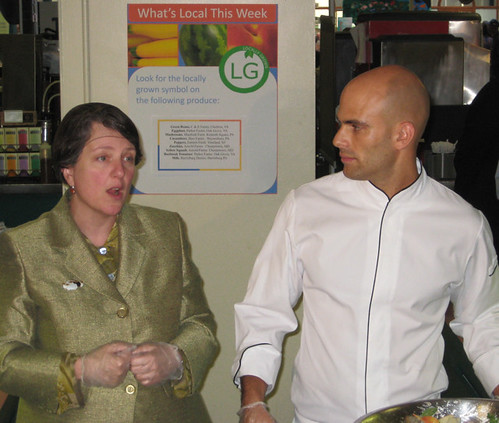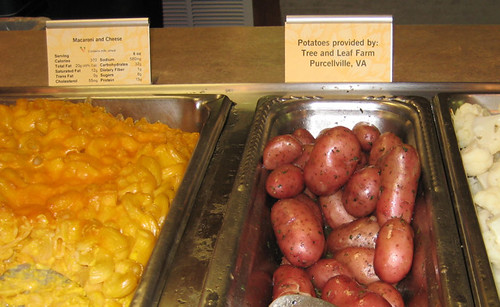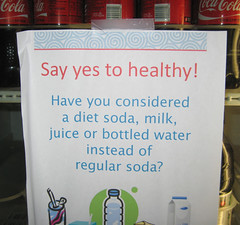USDA Deputy Secretary Kathleen Merrigan and White House Chef Sam Kass
I had the pleasure of dining on a lunch prepared by the White House Chef Sam Kass and so did tens of other USDA employees for whom he was making a salad with grilled chicken, apparently a favorite of the Obama family.
USDA Deputy Secretary Kathleen Merrigan donned a hair net and sanitary gloves to help him while talking with the employees in line. This was an effort - okay, photo op - to play up the local and regional initiatives that the USDA is launching this week in a program called Know Your Farmer, Know Your Food, led by Merrigan.
While the salad was a pleasant change from the usual fare at the USDA cafeteria, what seems far more significant is the program itself.
Nutrition and source labeling at USDA cafeteria as part of Know Your Farmer, Know Your Food
Although the press release mentioned $65 million in grants for the initiative this week, the figure obscures a key memo that Merrigan wrote on August 26 in which it's clear that many more millions -- in fact, hundreds of millions potentially -- could be available for local food systems. (HT to ObamaFoodorama).
But here's the key: non-profits, rural businesses, organic dairy associations (I'm thinking of one in particular), farmers, processors, need to apply for this money. It's there. They just don't know it.
One USDA staffer who has sat in on the biweekly meetings with Merrigan said it wasn't understood in-house that budgeted money could be targeted to build out local and regional food systems, "because no one had ever really thought about it before. We used the money for things like rural fire stations and hospitals or community centers, all really good things that are needed but don't do a lot to build up local food systems."
Merrigan was a bit more blunt when I button-holed her. "I understood that some of this money had been used to build fast food restaurants," she said. I got the distinct feeling such projects wouldn't be a rural priority for USDA any more.
So how much money is available?
According to the Merrigan memo (download PDF), one program alone, the Community Facilities Program, had more than $930 million in loan funds and $31 million in grants still available. (The memo lists relevant web sites to apply for the programs).
This money is targeted for community projects run by non-profits, local governments or Indian tribes, and it could, for example, pay for a kitchen for cooking classes, where farmers could drop off food. It might also fund farmers markets or community food banks. Last year, these loans averaged $665,229 each -- pretty good stimulus for a farmers' market.
Second, there's a business and loan guarantee program, which basically removes the risk from a private lender in making a loan in these tight-fisted times.
Through fiscal 2012, the USDA will set aside 5% of these loans for local and regional initiatives, such as setting up distribution facilities, or marketing local food. Five percent doesn't sound like a lot except when you consider it will amount to $100 million next year. I know a few regional food distribution co-ops that could use that money. They fall under the program as long as they transport their products no more than 400 miles. Bingo! The ones I'm thinking of probably qualify.
Finally, there's the Value-Added Producer Grant Program, which provides funding to agricultural producers who "add value" to products by processing or marketing them. Like selling to schools that want local food, or helping direct-market grass-fed beef to restaurants. It's aimed at farmers, ranchers, co-ops and other business ventures. Up to $100,000 is available for planning activities and up to $300,000 for working capital grants.
So don't let the programs specifically announced this week obscure the bigger picture. The USDA seems like it's making a multi-year effort to channel program money to local and regional food systems, but remember: it won't be spent if people don't ask for it.
All in all, I'd say Merrigan & Kass's USDA lunch was a success. I only heard a few quibbles about the price -- about 3 bucks more than the standard salad with chicken. As if to make the point, a guy in the check out line in front of me bought a burger and chips and soda for $6.13 (so much for the sign at left). My grilled chicken salad and water cost $11.99.
While the new vision seems on the mark, obviously there's much more policy work to be done to correct this dispiriting burger/salad disparity.
- Samuel Fromartz




